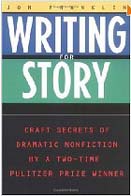Are you a planner or a spiller? Do you like to think ahead about your writing or do you simply like to get black on white and let the Muse take you where she will? Though there is much to recommend in both approaches, it really pays to be something of a planner when it comes to writing. You don’t need to know everything in advance about your story or book, but it’s good to know the broad outlines of it; this will allow you to focus on characterization, details and dramatic scenes.
Structure is the biggest challenge for most writers. While most have mastered sentence structure and paragraphing, they have trouble organizing individual paragraphs into a larger coherent story.

By using this outline, whether for a story or book, you’ll have a good chance of figuring out the larger shape of the story in advance. If you fail to do this, it’s like building a house without a strong foundation; it can easily collapse.
The dramatic outline allows you to chart the emotional peaks and valleys of the story so that you’ll know where you’re heading when you sit down to write.
The five short statements below describe the major actions in the story. There is one statement for each major focus.
This is not like the outline you wrote in English composition class; these statements highlight on the dramatic actions in story. They help you focus on what’s essential to the story.
This is a conflict-resolution outline, with the conflict introduced in the first statement, developed in the next three statements, and resolved in the last statement.
- Complication – Make it simple and active. Have you chosen active verbs to show action? Is the main character included statement? How will you illustrate the main action? Do you have the source material for this? Is the action dramatic enough?
- Development Action – Clear, cogent, related to complication.
- Development Action – Clear, cogent related to complication, tied to previous development, tied to main character.
- Development Action — Clear, cogent related to complication, tied to previous development, tied to main character.
- Resolution – Must fit the complication.
Writing this outline will save you a lot of time. You’ll be able to figure out in advance where the story is going. You can still change it as you go, but at least you’ll have a clear direction when you write the first draft of your story or book chapter.
For a more in-depth look at storytelling, please consider signing up for ones of my summer Seattle writing class, Writing for Story, or one of our online classes.
 The Writer's Workshop
The Writer's Workshop 











